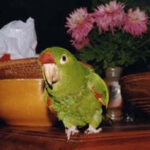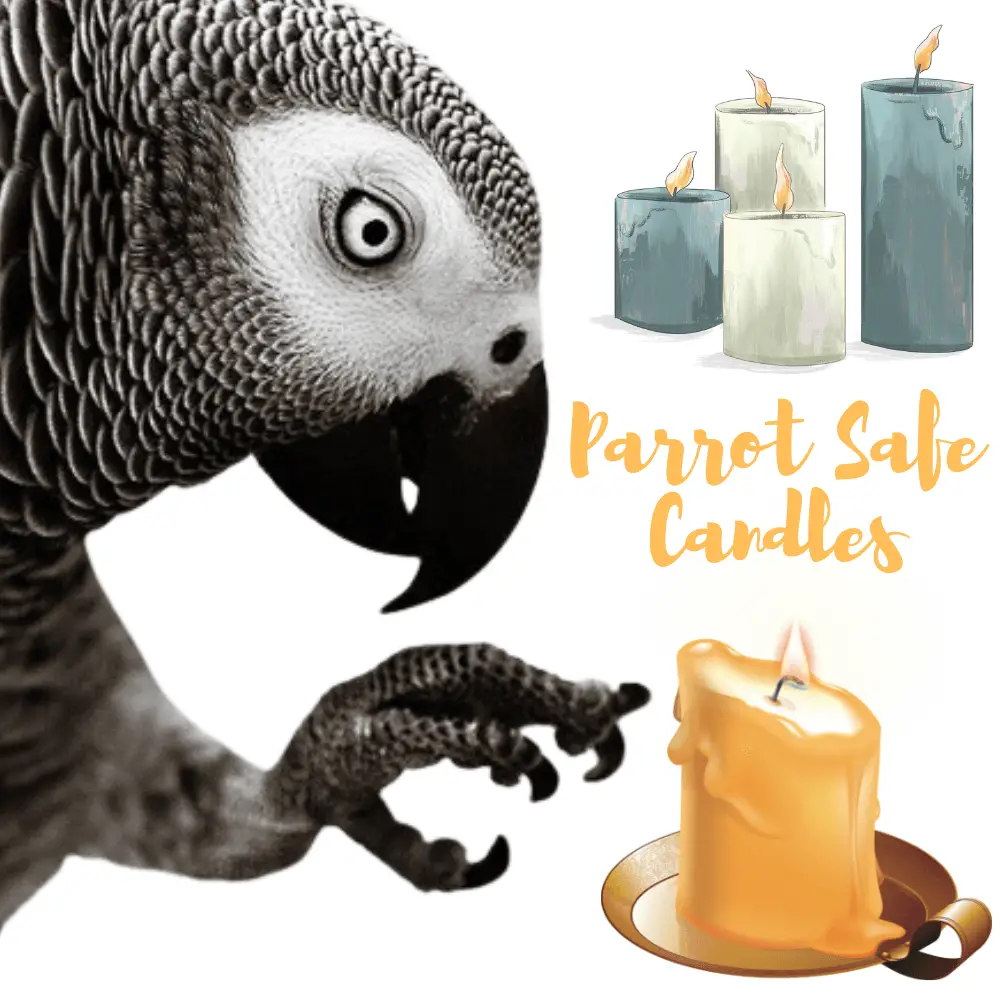
Parrot safe candles:The danger of heated essential oils and other scented candles for our parrots,When fall knocks on our door, the windows open less often than usual, our house is less often aired. It is then that scented candles, incense sticks and other scent diffusers generally make their reappearance.
But this can have serious implications for the lives of our parrots. This was the case with this lovebird at whose house a scented candle was lit every two days to compensate for the lack of fresh air, or at his companion’s who died the same day, only a few hours after him. Both showed visible signs of intoxication that their masters were unable to identify.
Their bodies were shaken with spasms, with tremors that made their feathers quiver. Then came the lack of balance, but again, no one understood. Alas, death was near. Yet no candle had been lit since the day before. This is just one example among many, unfortunately.
Essential oils actually contain volatile fats, which are released into the air very quickly when heated, much like soot on a wood fire.
For the most part, these substances act on the center of the nervous system. They can also irritate the eyes and respiratory tract depending on the gasoline used and its concentration. Our psittacidae are particularly sensitive to it, including when it comes to essential oils. Once heated, the most beneficial of oils thus becomes harmful to our birds.
So be careful when using this type of scented product in your home. Ventilate the rooms regularly, especially after using them. Also avoid their use in the room in which your “feathered beasts” are located, so as not to expose them unnecessarily. In case of observation of the symptoms described above, contact your veterinarian immediately, because at this stage, the intoxication is already very pronounced.
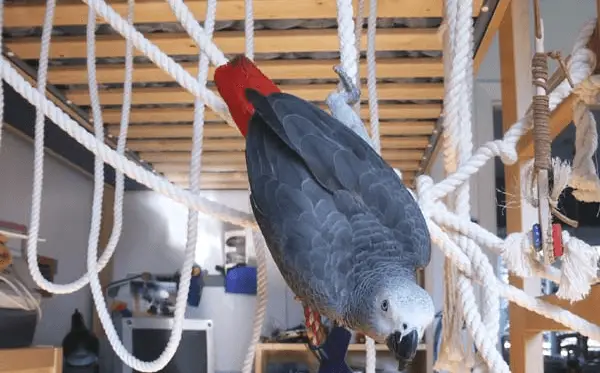
Dangling ropes pose
an enormous risk of strangulation for parrots.
Your parrot’s cage and the places it is allowed to visit in your home should be safe and secure for it. The same goes for his toys. The great curiosity of parrots prompts them to explore and they are not always able to recognize and avoid dangers.
It is therefore your responsibility to pay them adequate attention when they are having fun and to quickly identify any situation that could compromise their safety. Many accidents can be avoided if your supervision is adequate.
Giving toys to your parrot is very important. The resulting playful activities are of great benefit to your bird. Make sure, however, that all of your bird’s toys and games are adequate and safe for them. Learn how to inspect each accessory regularly to detect the slightest imperfection or damage that could make it unsafe.
Quickly throw out any damaged or old ones. Avoid giving away dangerous toys (examples: bell, accessories painted with toxic paints), even if they seem to be very popular. Often, I see parrots in a bad position at the clinic because the toy they used to play with has hurt or made them sick.
Kiki and the bells
Kiki is a happy lovebird who loves to have fun. Her favorite toy is a small wire mesh ball made of hard plastic with a bell inside. He carries it everywhere and bangs it against objects to hear the jingling of the bell. He also sometimes takes himself for a dog: he brings back the ball that Charles has fun rolling on the table. After a few months of use, the plastic on Kiki’s ball started to wear out and eventually she lost her bell.
It did not take more for the lovebird to develop an unconditional attachment to this bell. A good evening, so I see the owners of Kiki come into my consultation room, looking very worried, Showing me their little protégé and his new beak decoration… the parrot had managed to slide the lower part of its beak inside the slot in its bell and it got stuck there. All attempts to remove it had failed because it caused pain. The bell was so well embedded in the spout that I had to temporarily numb Kiki to remove it.
It was with the help of small pliers that I succeeded in spreading the edges of the slit opening of the bell to remove it without causing damage. Kiki has recovered very well from his adventure. The small irritation left by the passage of the bell on its beak quickly healed.
Needless to say that since that day, the little parrot no longer has access to the bells. They are removed from all the toys that his masters buy for him. In order to satisfy his need to make noise when he was having fun, he was given a small bell specially designed for parrots. Kiki quickly appreciated.
Parrot safe candles
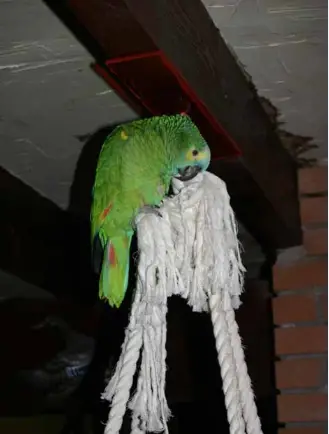
Robert’s blanket
Robert the Amazon has been limping since this morning and he constantly nibbles his front fingers on his left paw. No lesion is visible, but it expresses pain when touching the fingers in question. He is slightly drowsy and his appetite is a bit finicky. So he snuggled up against his blanket hanging from the bars of his cage.
This square of ragged fabric is everything for the parrot. Impossible to take it away from him, he is depressed. As the paw discomfort worsens, Robert is introduced to me. His owner insisted that he undergo an x-ray. She is convinced that he injured himself while antics.
The x-ray was ultimately not necessary. Close examination of the sore fingers revealed the presence of tiny nylon threads coiled tightly at their base. They partially cut off blood circulation. Once these threads were removed, a topical antiseptic was prescribed and everything was quickly back to normal.
The nylon threads came from the seam of the hem of the blanket that had recently been undone by Robert’s sharp beak. This type of wire is very dangerous for parrots because its flexibility allows it to be rolled up easily. Other birds have not had Robert’s luck.
They weren’t seen quickly enough and their fingers died from chronic lack of blood flow. A parrot could even strangle itself on this type of wire. Thoroughly inspect any pieces of fabric made available to your parrots and promptly remove any that are fraying. Carefully inspect all seams and remove any loose threads. Avoid fabrics with easily unraveled fibers and prefer fleece fabrics (polar ).
Parrot safe candles
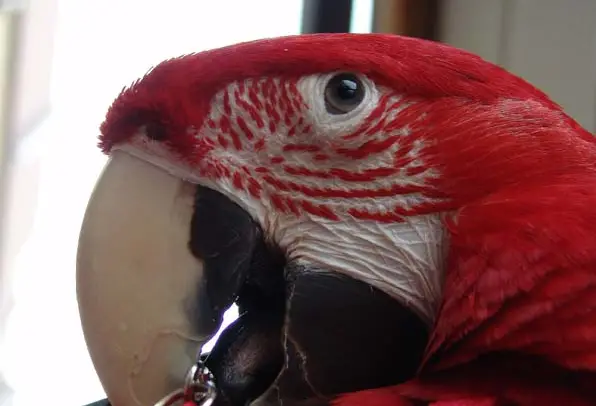
Roco’s chain
A chain is no stronger than the weakest of its links.
In the cage of Roco, the macaw, there are several accessories to distract him. Of all his toys, the large parrot prefers one made up of large pieces of colorful wood.
This large toy is held in place by an oval link chain that Roco loves to chew on. With his strong beak, he tries to open them by forcing the joint which is not welded. Fortunately, the chain is made of a metal which seems very durable. The parrot never managed to break it.
That morning, be taken with a greater force ( had he eaten spinach? …) or either because he had found the weak point in one of the links in the chain, Roco succeeded in partially twisting the metal. Happy with his feat, he persists in twisting it even more when Sophie hears a cry of horror. She runs up to Roco and sees him caught by the lower beak on the link of the chain he has just opened.
The piece of metal acts like a hook that pierces the delicate skin on the underside of the beak. Drops of blood begin to bead from the wound, and Roco threatens to panic at any moment, risking a serious aggravation of his precarious situation. Roco was really lucky. At the time of his accident, workers were busy outside the house. Using their large metal pliers, one of them finally succeeded, not without difficulty, to cut the link that held the parrot prisoner to the cage.
The wound inflicted by the metal was deep. It went completely through the skin from the underside of the beak to the tongue. Roco had difficulty eating hard foods for a while. Antibiotics and a pain reliever were prescribed to help his recovery.
Roco did not keep any consequences of this mishap. Today, there are no more chains in his cage and anything made of open rings is quickly eliminated. Antibiotics and a pain reliever were prescribed to help his recovery. Roco did not keep any consequences of this mishap.
Today, there are no more chains in his cage and anything made of open rings is quickly eliminated. Antibiotics and a pain reliever were prescribed to help his recovery. Roco did not keep any consequences of this mishap. Today, there are no more chains in his cage and anything made of open rings is quickly eliminated.
Parrot safe candles
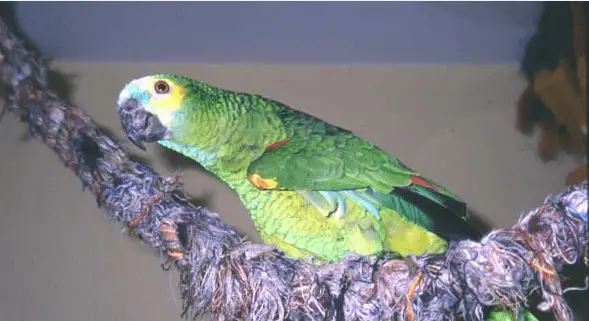
Lorita’s rope
A heavy cotton rope with knots at the ends is Lorita the Amazon’s favorite toy. She holds it between her paw and the perch and violently pulls the fibers to tear them off. Looks like a vulture tearing its prey apart. It destroys two to three ropes per month.
There is nothing problematic about this destructive activity in itself, except that one day Lorita began to suffer from constipation. On examination of the parrot’s stool, cotton fibers were found. Although her owner was convinced that she was not consuming it, he was fooled.
Daily observation of your parrot’s stool can quickly spot any changes in color, consistency, quantity, shape, etc. Quickly detecting a problem often allows it to be solved without the emergence of an unfortunate situation. Now Lorita can only have her rope in the presence of someone watching her closely.
Zazou’s tragic fate
White cockatoos have this tendency to swallow unusual things. In Zazou’s case, it cost him his life. Zazou had received a toy made of large blocks of wood. He took great pleasure in breaking them into small pieces the size of a match. Several weeks after the toy was destroyed, the parrot began to have abnormal stools: more watery and smelly.
He was also quieter and slept more. A few days later, he was found dead in the back of his cage. At autopsy, the cause of death was obvious: peritonitis secondary to perforation of the gizzard by a piece of wood the size of a match. The same toy is not necessarily safe for all parrots. It all depends on the use that each one makes of it.
I recommend closely watching a parrot playing with a new toy. If he seems to be misusing it, don’t hesitate to take it away. If in doubt, allow your bird to pick it up only when you are there to watch it.

All that glitters is not gold
Charlotte the cockatiel has a fascination with jewelry. She pulls the earrings and nibbles the chains that her mistress Julie wears around her neck. Anything shiny attracts the little parrot.
To please her, Julie bought her a chain of her own which she installed in her cage. Charlotte can do whatever she wants with this jewel… even get sick. Charlotte’s stools have been green for a few days now. Julie doesn’t worry too much, Charlotte has been eating broccoli lately.
She also has a tendency to lose her footing, but that does not worry Julie either, who considers her a little fat and therefore a little clumsy. Julie also believes that it is probably her gluttony that causes her to eat too quickly and regurgitate. Julie should have been worried. She eventually found Charlotte convulsing and comatose. She died on her way to the clinic.

The cause of his death: lead poisoning. Small rings of the chain put in his cage were found in his gizzard. As their metal was easily malleable, Charlotte had fun opening them and swallowing them.
Parrot symptoms ( green stools, loss of balance, regurgitation) were those of intoxication. Never overlook any changes in your parrot and consult quickly. An early diagnosis could have saved the life of this bird. If the chain had been gold, Charlotte would not have poisoned herself.
Inexpensive jewelry bought in big-box stores is very often made up of more or less toxic metals, including lead, which is very toxic. The moral of the story: never give your parrot accessories as a toy if they are not certified safe for birds or children.
11 Things That Can KILL Your Bird | Household Dangers to Pet Parrots
SOURCE:BirdTricks
RELATED ARTICLES:


